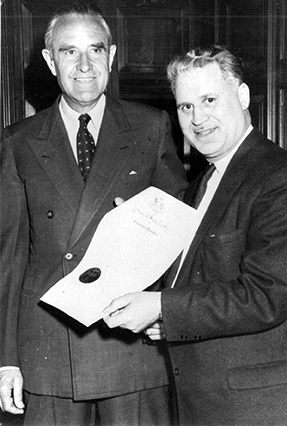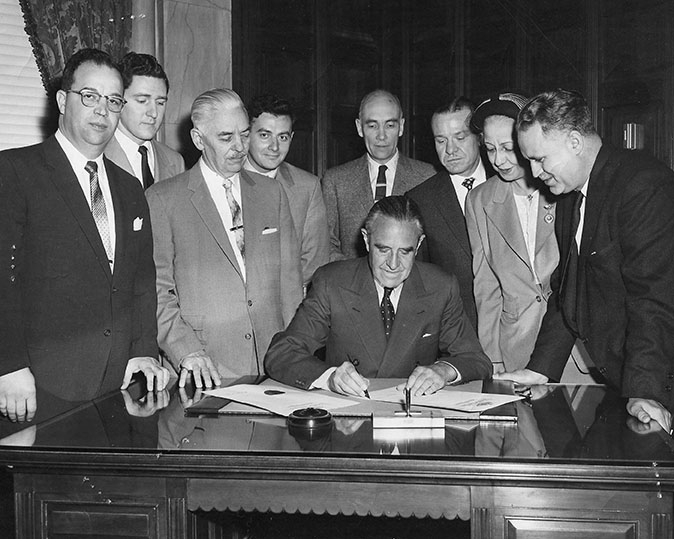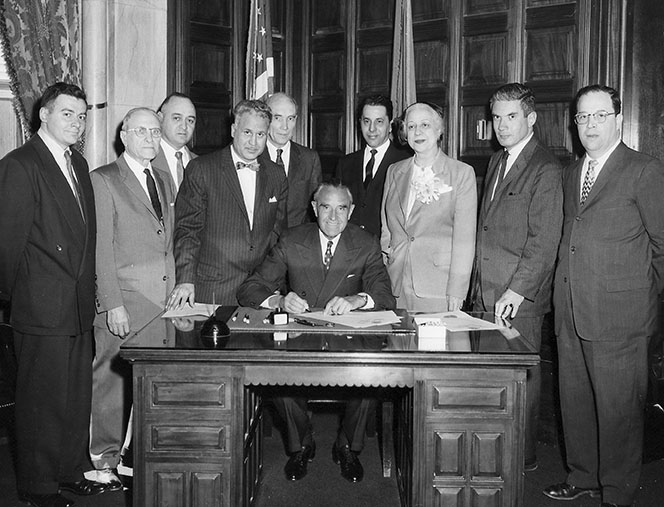Although occasionally cited in American history books, Verrazzano remained virtually unknown as the discoverer of New York Harbor, being overshadowed by the English explorer, Henry Hudson who arrived in New York Harbor over 80 years later in 1609. This state of affairs remained until John N. LaCorte and the Italian Historical Society of America set out to bring to Verrazzano the recognition he deserves. In 1952 the Society sponsored the rededication of the Verrazzano monument in Battery Park, New York City. The monument had previously been removed during the construction of the Battery Tunnel. In this endeavor, the Society received the invaluable assistance of James Angelo Kelly, Historian of Brooklyn and a committed friend of the Society, and Jacques Herbert, historian and publisher of New York's French newspaper.
Averil Harriman, Governor, State Of New York with John N. LaCorte,
authorizing the naming of the Verrazano-Narrows Bridge.
The Society undertook a major campaign of disseminating historical material on Verrazzano to publishers, historian, libraries and almanac publishers throughout the country. In 1954 the Society was successful in having April 17 proclaimed Verrazzano Day by Mayor Robert Wagner. This was followed in 1957 when Governor Harriman presented the first proclamation from the State of New York. By this time plans were on their way to build a suspension bridge joining Brooklyn and Staten Island. Governor Harriman pledged his assistance and support in having the proposed span named in honor of Verrazzano.
The Society unremittingly pursued this goal. At the request of the Society, the Governors of the States of New Jersey, South Carolina, Rhode Island, and Maine also issued Verrazzano Day proclamations which confirmed the fact that these states were discovered by Verrazzano. With these five proclamations in hand, the Director of the Society, John N. LaCorte, spoke to the manager of the Triborough Bridge and Tunnel Authority, repeating his request (which had been denied in 1951) that the proposed bridge be named in honor of Verrazzano. The manager stated that he had never heard of Verrazzano and that the name was too long and difficult to spell and pronounce. LaCorte countered with the names of other bridges with ostensibly difficult names.
This began the struggle between head if the Triborough Bridge and Tunnel Authority, Robert Moses who said that the bridge would be named after Verrazzano over his dead body. He was the unquestioned, and unelected, power lord of all major public projects in New York. He has been called the architect of New York City, and indeed, under his leadership, many public projects that are vital to the life of New York City are permanently in place. He had virtual absolute authority to determine what was built and what it was named. With his opposition to the naming of the bridge after an Italian, an insurmountable obstacle seemed to have been put in place. However, Robert Moses was not prepared to meet the likes of John N. LaCorte who was relentless in the pursuit of what he believed to be right and just. (See the excellent biography by Robert Caro entitled The Power Broker: The Fall of the City of New York published in 1975.) After a considerable struggle that was not untouched by the very anti-Italian prejudice that the Italian Historical Society of America was established to overcome, it was finally decided that the official name of the bridge would be the Verrazzano-Narrows Bridge.
Gov of NY A. Harriman reauthorizing the naming of the Verrazano-Narrows Bridge.
Gov of NY Avril Harriman signing authorization of the naming of the Verrazano-Narrows Bridge.
Once the bill naming the proposed bridge in honor of Verrazzano was introduced in the State Assembly, the Staten Island Chamber of Commerce joined the fight against the name. In 1960, Governor Rockefeller signed the bill naming the bridge, temporarily settling the controversy.
The day after the death of John F. Kennedy, another difficult battle confronted the Society. Thousands of signatures had been obtained for changing the bridge's name in honor of the fallen president. At this point, John N. LaCorte made a direct call the Attorney General and brother of the President, Robert Kennedy. LaCorte had met the Attorney General in connection with his efforts to have another Italian, Joseph Bonaparte, recognized as the founder of the Federal Bureau of Investigation. LaCorte appealed to Kennedy who immediately assured him that he would make sure that there would be no change in the naming of the bridge.
Finally, on November 21, 1964, the Verrazzano-Narrows Bridge was opened. Even after all of this, some radio announcers and newspapers sought to omit Verrazzano's name, referring to the bridge as the Narrows Bridge, or even the Brooklyn/Staten Island Bridge, but eschewing any reference to the Italian explorer. One final time the Society went to work and asked for the help of Attorney General Louis Lefkowitz who gave his support. Eventually, after many years of struggle and perseverance, "Verrazzano" became the name most commonly used to identify the bridge, giving this Italian navigator the recognition he so justly deserves.
The Verrazzano Bridge symbolizes the spirit of committing to an idea and following through to the end. Without the singular efforts of John N. LaCorte, the naming of the bridge after the navigator who piloted the first European ship to pass through the waters which it traverses would not have occurred.



